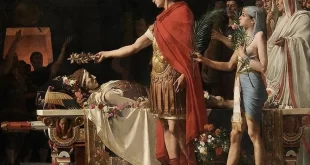1- The cursed blades of Muramasa

Fans of Japanese history will no doubt recognize the name of Muramasa, a famous blacksmith who has gone down in legend thanks to the quality of his work and the dark reputation of his weapons. In historical texts, he is often put in duality with Masamune, generally considered to be the greatest blacksmith in the history of Japan.
Apart from their rather unique model and excellent quality, the reputation of Muramasa weapons comes from a folklore that has developed over time. His creations are often described in legends as cursed blades, which incited violence and bloodlust in the samurai who used them.
This reputation is due to the popularity of these blades in parts of Japan in the 16th and 17th centuries, where they were used in several bloody conflicts, accidents and even suicides. These tragedies were picked up by the theater and fed into folklore writings, which gradually gave Muramasa’s creations a reputation as cursed blades.
Many weapons forged by Muramasa are still in excellent condition today and are sometimes displayed to the public in major Japanese museums.
2- Zulfikar: sword of ali ibn abi talib

This saber belonged to the prophet Mohamed who also had 6 or 8 sabers. Each sword had a name, it was called Dhul Fikar which means “two-pointed sword”, “Sharp spine” or “the one that distinguishes good from evil”.
At the time, the sword was the symbol of holy war where courageous soldiers protected the message of Islam.
During the Battle of Uhud, Ali smashed his saber on an opponent’s helmet. Mahomet wore two sabers on his belt. He gave his Zulfikar sword to his son-in-law Ali.
This sentence :
“There are no heroes like Ali, There is no sword like Zulfikar”
is a common slogan. It happens that the order of the two independent propositions are reversed.
3- La Joyeuse, the sword of the French monarchy

This saber is one of the oldest historical artifacts of the French monarchy. According to experts, the Joyeuse has been used for the coronation of new monarchs since the 12th century.
This sword is surrounded by several myths. Certain religious writings report in particular that an earlier version of the Joyeuse would have belonged to the emperor Charlemagne in person and that it would have been forged from the lance which would have pierced the body of Jesus Christ.
Although these legends are arguably much closer to myth than reality, the true journey of this sword remains fascinating. From monarch to monarch, it survived the French Revolution to then be used during Napoleon’s coronation. Its various components have been modified over the centuries, which also testifies in a way to the great history of France.
Since the French Revolution, the Louvre has been responsible for the maintenance of this legendary blade, and it is sometimes possible to see it at exhibitions.
4- Simón Bolívar’s sword

Venezuelan general, Simón Bolívar was also president of several Latin American countries in the 19th century and is recognized as one of the great leaders of the movement that led to the independence of these former Spanish colonies. While his sword is certainly not as old as the other blades mentioned so far, it does have a fascinating history.
This legendary weapon is indeed almost as legendary as its owner; she always accompanies him on his portraits or on the many statues bearing his effigy, and she was by his side until his death in 1830. More than a simple sword, it has become a symbol of liberation for several countries of the world. Latin America, starting with Colombia.
After his death, his sword was kept in his former residence in Bogota, until it was stolen in 1974 by the Colombian revolutionary group M-19. The sword was reportedly returned to the Colombian government in 1991, after it was owned by drug trafficker Pablo Escobar, but doubts remain as to its authenticity.
In 2010, the Revolutionary Armed Forces of Colombia (FARC) claimed to have the relic in their possession, but the Colombian government quickly denied the veracity of this statement before again claiming to be in possession of Simón’s real sword. Bolívar.
5- Sword of Alexander the Great

Alexander III of Macedon, better known as Alexander the Great, was King of Macedon from 336 BC until his death and is recognized as one of the most prominent military leaders in history, by his conquest of the Achaemenid Empire. Alexander had indeed conquered the Persian Empire, including Anatolia, Syria, Phenicia, Judea, Gaza, Egypt, Bactria and Mesopotamia, he extended the borders of Macedonia to the Punjab region. . Before his death, Alexander had planned to return to the West and conquer Europe in addition to wanting to continue expanding to the East and find the end of the world, an idea that his childhood guardian, Aristotle, told him. instilled in telling stories about a place where the Earth ended and the Great Outer Sea began.
6- Sword “Tizona” and Sword “Colada”

They belonged to the castellan knight Rodrigo Díaz de Vivar, known as “El Cid Campeador”, faithful vasalle who participated with king Alfonso VI in the conquest of Toledo and, later, he conquered the kingdom of Valencia, which was in the hands of the Arabs. .
7- Richard the Lionheart Sword

Famous King of England between 1189 and 1199, being the third son of King Henry II of England and Eleanor of Aquitaine. He was also Duke of Normandy and Aquitaine and Conte d’Anjou, noble Crusader Knight, recognized for his courage and valor in battles. Richard received the title of Coeur de Lion in the Crusades, being compared to Philippe d’Orléans as a lamb and Richard as a lion. His personal worth in battle inspired many poets and literary people.
8- King Arthur’s Excalibur Sword

Its story belongs mainly to legend and early 15th century literature, although it is still doubtful whether Arthur, or a similar figure sure that the legend was based, actually existed. Legend and history mingled during several subsequent centuries and appear to be intimately united to the Knights of the Round Table and the mysterious “Excalibur”.
According to had announced the mage Merlin, only who will get to withdraw the sword from the rock, would be King. Arthur achieved this feat and kneeling before the stone, he extracted the blade with the usual ease, he supported the sword on his head and then he entered the cathedral and laid it on the altar. Arthur was anointed with holy oil in the presence of all the Barons and the common people, he solemnly swore to be a loyal king for his subjects and to defend truth and justice every day of his life.
9- Sword of William Wallace (1270-1305)

He was a valiant Scottish warrior who led his country against the English occupation and against King Edward I of England in the Scottish Wars of Independence. He was brought up in an abbey in which his paternal uncle resided, for this he was well educated for the models of the time, and spoke French, Latin, Gaelic and English.
10- Haft (Arabic: الحتف , “the ruin” or “the death”)

Is a sword that King David would have forged himself after God taught him ironwork and weapon-making as a reward for slaying the giant Goliath. He would have taken as a model Al-Battar , the sword of Goliath, making a wide blade 112 cm long. The weapon was allegedly taken by Muhammad as booty during his victory over the Jewish tribe of Banu Qaynuqa, since then part of the nine swords known as Muhammad. A sword presented as such is now in the Topkapi Museum in Istanbul
 medjouel.com Study Non Stop
medjouel.com Study Non Stop


